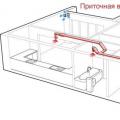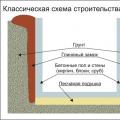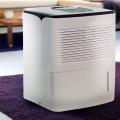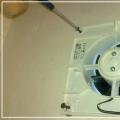The presence of an indoor reservoir in the house requires the arrangement of a system for removing water condensate outside the building. Proper ventilation of the pool allows you to increase the wear resistance of the structure of the house. Its creation requires taking into account many components. After reading this article, the reader will learn about the main ways to maintain the desired microclimate in the pool, the rules for designing and calculating the moisture removal system.
Why do swimming pools need to reduce the level of humidity
In the room where the pool is located, there is always an excess of moisture. Water molecules are constantly evaporating, this physical process cannot be stopped. Particles fall on walls, ceilings, windows, decorative elements, condense on surfaces with a lower temperature.
High humidity creates certain problems for residents.
- The discomfort. Being in a room becomes uncomfortable: people may experience a lack of oxygen, it becomes difficult to breathe. In this case, being and swimming in the pool will not bring relaxation and pleasant emotions. Windows will fog up, outerwear will become damp.
- Damage to interior items and equipment. Moisture will settle on various things, including electrical equipment, causing it to fail.
- Corrosion. All metal structures in the room are quickly covered with rust and destroyed.
- Rapid wear of room decoration materials. Due to condensation, the paint gradually fades, stains appear. The plaster begins to swell and collapse.
- Reproduction of pathogenic bacteria and fungus. Heat, together with high humidity, leads to the active spread of molds, the appearance of microorganisms that are harmful to health.
The ventilation of the pool in the cottage solves all these problems in a natural way. Removing excess moisture increases the life of the entire structure of the house, interior decoration and helps maintain the health of residents.
microclimate requirements
The Russian authorities have adopted a set of building codes, according to which it is possible to create swimming pools in private homes. Details of them can be found in the 3rd section of the SNiP "On public buildings and structures" and, specifically, in the reference manual "Design of pools".
The main priority of the moisture and air removal system in rooms with water tanks is to maintain an acceptable level of humidity in the internal environment. Together with other factors, it should also solve the problem of removing excess heat in the required volume.
The main requirements are shown in the following table.
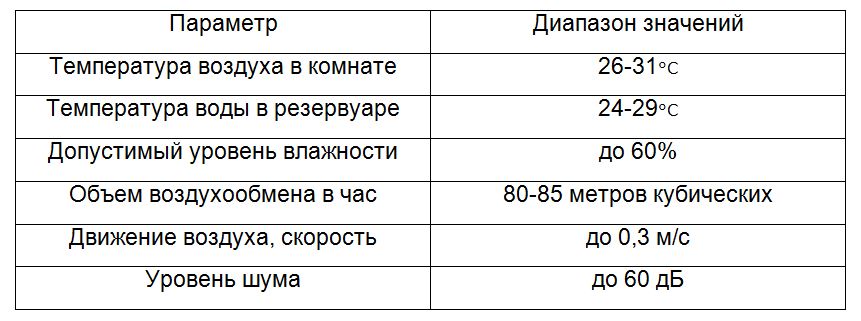
The maximum permissible humidity level is 65%.
Ventilation in a room with a pool should not allow the formation of stagnant zones, from where moisture will not be removed.
Types of pool ventilation systems in a private house
The two most common ventilation installations are described below:
- supply and exhaust;
- with air separation.
Supply and exhaust ventilation
The supply and exhaust ventilation system for the pool allows you to evenly remove air saturated with moisture, carbon dioxide, chlorine and other substances harmful to health, and replace them with fresh air. The possibility of drafts is excluded.
In the conditions of the Russian climate, it is advisable to purchase additional equipment - a heat recuperator, which helps to reduce energy consumption by more than 50%. The recuperator uses the available heat in moisture and gases to heat cold air masses from outside.
The system consists of the following parts:
- fan for drawing in and drawing out air;
- a valve that does not allow cold masses to enter the room after the equipment is turned off;
- recuperator;
- air dryer.
Some models are also equipped with filters for cleaning the incoming masses.
A diagram of such a ventilation system is shown in the figure: 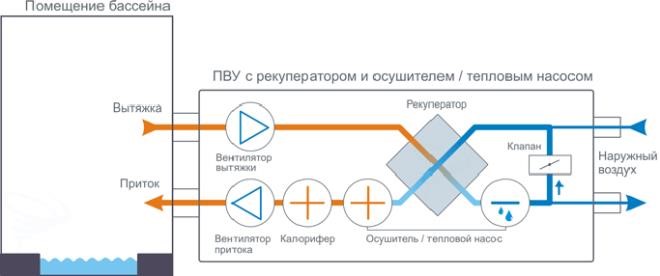
Installation is simple, suitable even for rooms with a small area. This ventilation is not connected to the house exhaust system, which makes installation easier. All equipment is located in one block. The recuperator allows you to quickly recoup the cost of purchasing equipment.
Ventilation with air separation
It is somewhat more complicated, since different components of the system are involved in the inflow and outflow of air masses.
The supply of fresh air and the removal of air saturated with moisture and gases occur simultaneously. This is possible due to the use of several fans and a device for the intake of used air.
Installation of such a ventilation system should be carried out at the stage of building a pool room. It has a larger size, suitable for rooms with a large area and the volume of the water tank.
Consists of the following components:
- device for collecting used gases. Usually located on the ceiling in the center of the room. Equipped with exhaust fans and a valve that does not let cold air through when the equipment is turned off;
- a set of fans that provide fresh air;
- filter for cleaning incoming masses;
- a heater for heating them;
The system is controlled by an automatic unit that maintains a constant volume of air at the desired temperature.
The figure shows this ventilation system: 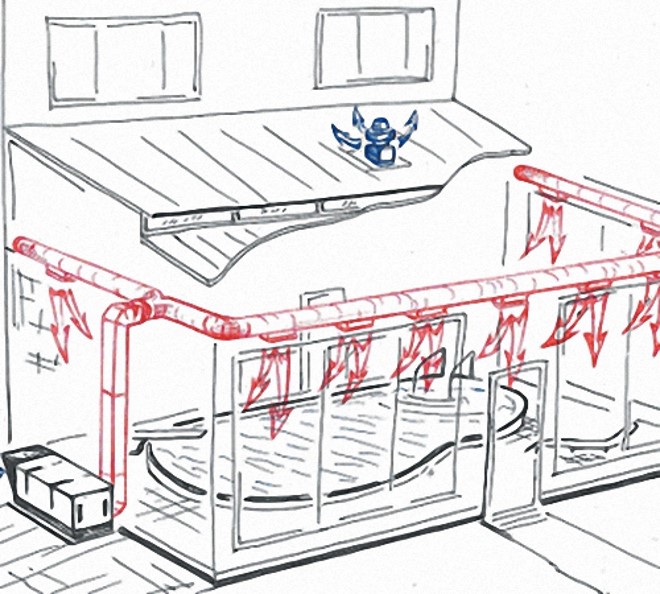
Pool air conditioners are now gaining popularity - these are fully automated devices that maintain the microclimate in the premises in several modes:
- heating: built-in thermal equipment warms the air to the required value;
- dehumidification. The air entering the pump is cooled, the moisture condenses and is collected in a special container. The dried air mass is in the heat exchanger and is soon fed into the room;
- supply of fresh air from outside. It is filtered and heated to a predetermined temperature.
Air conditioners for the pool can significantly improve and automate the ventilation system or even replace it.
What to consider when planning
During the creation of an air exchange project in the pool, it is necessary to take into account various factors and indicators. The first step is to analyze the very design of the room where the tank is located: all the characteristics, quality and features of finishing materials. If necessary, additional equipment for dehumidifying the air should be included in order to prevent rapid deterioration of the structure. It is important to prevent the accumulation of condensate, especially on the surface of the ventilation shaft.
For the subsequent calculation, you will need to find out the values \u200b\u200bof the following indicators:
- the size of the entire room;
- average attendance of the room (number of people visiting the pool);
- the total size of the body of water;
- water and air temperature;
- average temperature in winter and summer outside;
- air temperature directly under the ceiling.
The last point is justified due to the fact that warm air always tends to rise.
Project calculation
The calculation is made using special formulas that will allow you to determine the air exchange rate and other key indicators in a particular situation.
In addition to the above indicators, one should take into account the level of heat and moisture from bathing people, solar exposure, directly to the surface of the water.
Pool ventilation calculation:
1. Formula for determining air exchange.
W=e×F×Pb – PL, where:
e is the evaporation coefficient;
F is the total size of the water surface (in square meters);
Pb is the level of water vapor pressure in the air saturated with moisture at a given temperature (in bar)
PL is the level of water vapor pressure, taking into account the set temperature and the desired humidity (in bar).
2. Formula for determining the air flow rate.
By weight: mL=GW×XB – XN,
By volume: L=GWr×XB – XN, where:
GW is the total volume of moisture evaporation in the room (grams per hour);
XB - the level of humidity in the room with the pool (grams per kilogram);
XN is the moisture level outside the pool room (grams per kilogram);
r - air density at the desired temperature (kilogram per cubic meter)
During the subsequent installation of the moisture and air removal system, these indicators are taken into account - this allows you to increase the wear resistance of the whole house and reduce operating costs.
Summing up
Ventilation in the pool of a private house is a complex system, the design of which requires the calculation of various formulas, knowledge of the correct schemes and features of the impact of moisture on materials. Often tenants order help from specialized companies, but everything can be done by hand. The above information will allow the reader to independently carry out all the work to create a project for his pool, take into account all the features of his situation and anticipate unnecessary costs.

